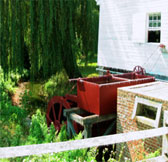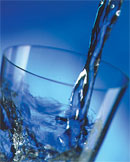

 What is it that makes Earth different from all other planets? It is water. Because we have water we have life. Today’s space explorations are largely focused on the search for water on the moon and on Mars so that man can survive in those inhospitable environments with less reliance on our home planet.
What is it that makes Earth different from all other planets? It is water. Because we have water we have life. Today’s space explorations are largely focused on the search for water on the moon and on Mars so that man can survive in those inhospitable environments with less reliance on our home planet.
The early great civilizations of the world all grew up along the major fresh water sources: the Nile, the Yellow River, the Tigris and Euphrates, etc. Without water there is no agriculture.
Every culture in the world developed canals and impoundments to bring fresh water to their crops. At times these projects had negative consequences by leaving behind salts which ultimately ruined the land. Sedimentation occurred behind the dams resulting in poorer soils in downstream areas. Fisheries were often damaged or eliminated, but people were largely fed and towns managed to grow around these projects.
Even with impoundments, drought continues to pose problems for much of the world. From the devastation of the “dust bowl” of the 1920s and 1930’s in the United States to the Sahel of North Africa, hunger, sickness and death remain too real.
About 70% of the earth is covered with water, but only 2% is fresh and of that, 2/3 is locked in polar ice and glaciers. Throughout much of the world the fresh water has been so compromised by pollutants that it is a public health hazard.
Water was and still is a source of power which through the millennia has enabled mankind to be relieved of intensive labor such as grinding grains and sawing wood. Many of the old water wheels still exist and are still in operation. In the United States these are often used for small tourist/educational purposes such as the one in Wye Mills, Maryland where you can buy flour ground by massive stones powered by water.
Jobs have been created and the industrial revolution came about largely through the power of running water. From the looms of Samuel Slater in Pawtucket Rhode Island in 1793, to the musket factory of Springfield, Massachusetts, to the Hopewell Ironworks of Pennsylvania – all were powered by water. Mills and factories along the Jones Falls were the heart of early industrial Baltimore.
In the 20th century massive hydroelectric dams provide both power and water for cities and for agriculture. Without the Hoover Dam, Las Vegas would be a dusty little town. The Conowingo Dam (1928) on the Susquehanna River, provides hydroelectric power, cooling water for the Peach Bottom Nuclear Generating Station, flood control, recreational opportunities and drinking water for Baltimore and other jurisdictions.
Water transportation is still vital to commerce. Early canals connecting freshwater bodies of water enabled agricultural, animal and mineral products to be easily transported from the interior of North America to the east coast and beyond. Here in Maryland the C&D canal is still a vital link between the Chesapeake Bay and the Delaware River.
 The Bureau of Water and Wastewater provides water to Baltimore City and portions of Anne Arundel, Baltimore, Carroll, Harford and Howard Counties. We service close to 2 million people daily. Residents, industry, agriculture and recreation all thrive because of our stewardship.
The Bureau of Water and Wastewater provides water to Baltimore City and portions of Anne Arundel, Baltimore, Carroll, Harford and Howard Counties. We service close to 2 million people daily. Residents, industry, agriculture and recreation all thrive because of our stewardship.
All of this comes down to one simple fact: water is vital yet relatively inexpensive so many of us take it for granted. That one glass of water gives you life. That plumbing in your house keeps you healthy. That reservoir in your community makes everything in your life possible.